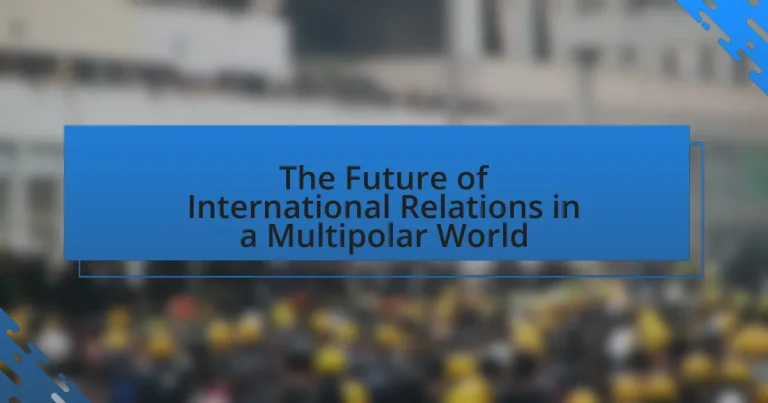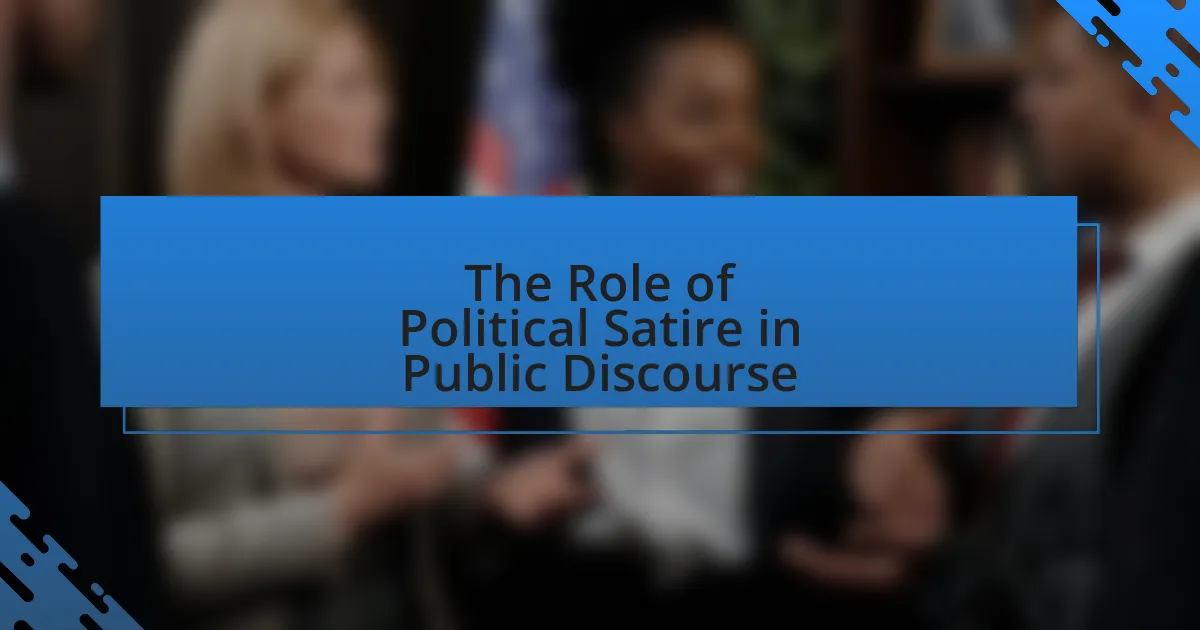The article examines the implications of a multipolar world for international relations, highlighting the shift from unipolarity and bipolarity to a system where multiple nations exert significant influence. It discusses the characteristics of multipolarity, including the emergence of new global powers like China and India, and the resulting changes in global governance and power dynamics. Key topics include the evolution of alliances, the impact of economic growth and technology on power shifts, and the challenges and opportunities presented by a multipolar landscape, such as increased geopolitical tensions and enhanced collaboration on global issues. The article emphasizes the need for adaptive strategies in diplomacy and international cooperation to navigate this complex environment.
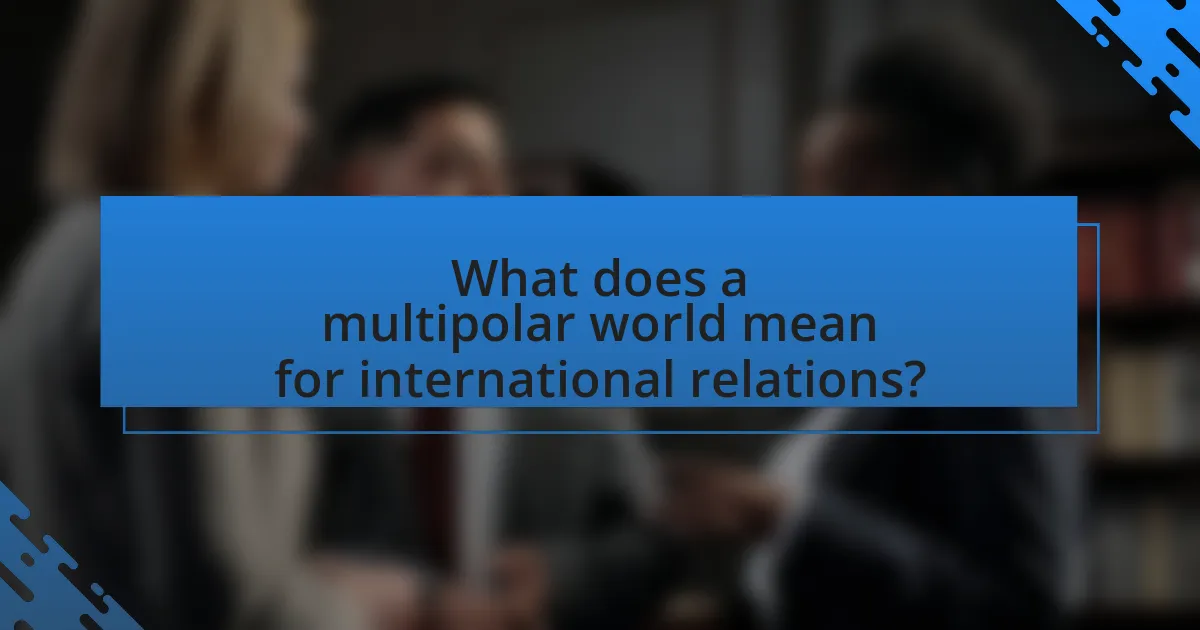
What does a multipolar world mean for international relations?
A multipolar world means that multiple nations hold significant power and influence in international relations, rather than a single dominant superpower. This shift leads to a more complex global landscape where countries must navigate a web of alliances, rivalries, and negotiations. For instance, the rise of China and India as major global players alongside the United States has resulted in a reconfiguration of trade agreements, military partnerships, and diplomatic strategies, as seen in initiatives like the Belt and Road Initiative and the Quad alliance. This multipolarity encourages greater collaboration and competition, impacting global governance and international norms.
How does the concept of multipolarity differ from unipolarity and bipolarity?
Multipolarity differs from unipolarity and bipolarity in that it involves multiple states or entities holding significant power and influence in the international system, rather than a single dominant power or just two competing powers. In unipolarity, one state, such as the United States post-Cold War, exerts predominant influence globally, while in bipolarity, two states, like the U.S. and the Soviet Union during the Cold War, compete for power and influence. Multipolarity, as seen in the current global landscape with the rise of powers like China, India, and the European Union, creates a more complex and interdependent international environment where no single state can unilaterally dictate global affairs. This shift is evidenced by the increasing collaboration and competition among various nations in economic, military, and diplomatic arenas, reflecting a departure from the dominance of a single or dual power structure.
What are the key characteristics of a multipolar world?
A multipolar world is characterized by the presence of multiple influential states or power centers that shape global politics and economics. In such a system, no single nation dominates, leading to a balance of power among various countries. This structure encourages diverse alliances and partnerships, as nations seek to enhance their influence and security through collaboration. Additionally, a multipolar world often results in increased competition for resources and geopolitical influence, as emerging powers challenge established ones. Historical examples include the post-World War II era, where the United States, the Soviet Union, and other nations played significant roles in global affairs, demonstrating the dynamics of a multipolar system.
How does multipolarity influence global power dynamics?
Multipolarity significantly influences global power dynamics by redistributing power among multiple states rather than concentrating it in a single or dual hegemony. This shift leads to increased competition and collaboration among various nations, as seen in the rise of regional powers like India and Brazil, which challenge traditional dominance by the United States and China. The emergence of multipolarity fosters a more complex international landscape, where alliances are fluid and states must navigate a web of relationships to pursue their interests. For instance, the BRICS coalition, comprising Brazil, Russia, India, China, and South Africa, exemplifies how countries can unite to enhance their influence against Western-led institutions. This dynamic not only alters diplomatic strategies but also impacts global economic policies and security arrangements, as nations seek to balance power and assert their sovereignty in a more interconnected world.
What are the implications of a multipolar world for global governance?
A multipolar world implies a shift in global governance dynamics, leading to increased complexity and competition among multiple power centers. In this context, traditional Western-dominated institutions may face challenges in authority and effectiveness, as emerging powers seek to reshape global norms and rules to reflect their interests. For instance, the rise of China and India has prompted calls for reforms in institutions like the United Nations and the International Monetary Fund to better represent the interests of developing nations. This shift can result in fragmented governance structures, where regional powers exert influence over specific areas, complicating consensus-building on global issues such as climate change and security. Additionally, the multipolarity may foster a greater emphasis on bilateral and regional agreements, as states prioritize their strategic interests over multilateral cooperation.
How do international institutions adapt to a multipolar landscape?
International institutions adapt to a multipolar landscape by reforming governance structures and enhancing collaboration among diverse state actors. These institutions, such as the United Nations and the World Trade Organization, recognize the need for inclusive decision-making processes that reflect the interests of emerging powers like India and Brazil, alongside traditional powers like the United States and the European Union. For instance, the UN Security Council has faced calls for reform to include more permanent members, thereby addressing the shifting balance of power. Additionally, international institutions are increasingly engaging in partnerships with regional organizations, such as the African Union and ASEAN, to address global challenges collaboratively. This adaptive approach is evidenced by initiatives like the G20, which brings together both developed and developing nations to discuss economic governance, reflecting the multipolar reality of global politics.
What role do emerging powers play in shaping global governance?
Emerging powers play a crucial role in shaping global governance by influencing international norms, policies, and institutions. These nations, such as Brazil, India, and South Africa, contribute to a more multipolar world by advocating for reforms in global governance structures, like the United Nations and the World Trade Organization, to better reflect the interests of developing countries. For instance, the BRICS group (Brazil, Russia, India, China, and South Africa) has pushed for greater representation and decision-making power for emerging economies, highlighting their collective economic weight, which accounted for over 40% of the world’s population and significant portions of global GDP. This shift challenges the traditional dominance of Western powers and promotes a more inclusive approach to international cooperation and policy-making.
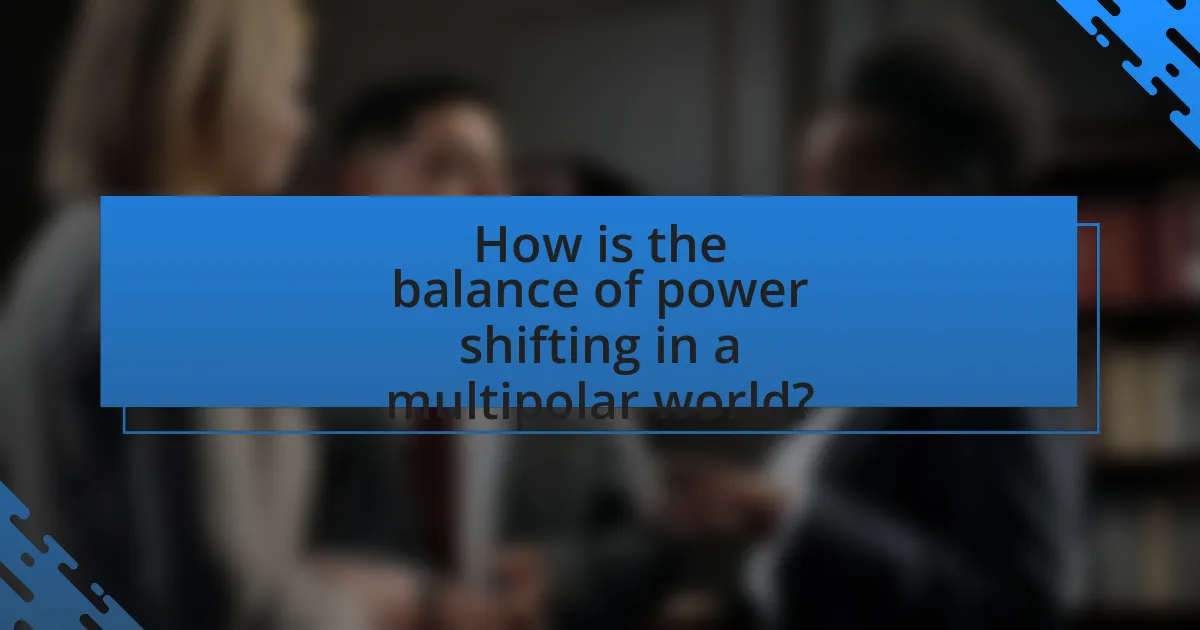
How is the balance of power shifting in a multipolar world?
The balance of power is shifting in a multipolar world as emerging economies and regional powers increasingly challenge the dominance of traditional superpowers like the United States. This shift is evidenced by the rise of countries such as China and India, which have expanded their influence through economic growth, military modernization, and strategic partnerships. For instance, China’s Belt and Road Initiative has significantly increased its geopolitical reach, while India’s active participation in regional organizations like the Quad demonstrates its growing role in security dynamics. Additionally, the decline of U.S. unilateralism, highlighted by its withdrawal from international agreements and alliances, has created space for other nations to assert their interests, further contributing to a more distributed global power structure.
What factors contribute to the rise of new global powers?
The rise of new global powers is primarily driven by economic growth, technological advancement, and demographic changes. Economic growth enables countries to increase their influence through trade, investment, and military capabilities; for instance, China’s GDP growth has positioned it as a leading global power. Technological advancement, particularly in information technology and renewable energy, allows nations to innovate and compete on a global scale, as seen with India’s IT sector. Demographic changes, such as a youthful population in countries like Nigeria, provide a labor force that can drive economic expansion and innovation. These factors collectively enhance a nation’s ability to assert itself in international relations, contributing to a multipolar world.
How do economic growth and military capabilities affect power shifts?
Economic growth and military capabilities significantly influence power shifts by altering the balance of influence among nations. Economic growth enhances a country’s resources, enabling increased investment in military capabilities, which in turn strengthens its geopolitical position. For instance, China’s rapid economic expansion over the past few decades has allowed it to modernize its military, resulting in a shift in power dynamics in Asia and beyond. The Global Firepower Index ranks countries based on military strength, illustrating how nations with robust economies, like the United States and China, maintain superior military capabilities, thereby affecting global power structures. This correlation between economic strength and military prowess is evident in historical contexts, such as the post-World War II era, where the economic recovery of Western nations facilitated military alliances that reshaped international relations.
What impact does technology have on the balance of power?
Technology significantly alters the balance of power by enhancing military capabilities, economic competitiveness, and information dissemination. For instance, advancements in artificial intelligence and cyber capabilities allow nations to conduct warfare more efficiently and covertly, shifting power dynamics. The 2020 U.S. Department of Defense report highlights that countries leveraging cutting-edge technologies can gain strategic advantages, as seen in the rapid development of hypersonic weapons by Russia and China, which challenge traditional military superiority. Additionally, technology facilitates the rise of non-state actors and transnational networks, further complicating power structures in international relations.
How do alliances and partnerships evolve in a multipolar context?
Alliances and partnerships evolve in a multipolar context through adaptive strategies that respond to shifting power dynamics among multiple influential states. In a multipolar world, countries reassess their alliances based on changing geopolitical interests, economic interdependencies, and security concerns. For instance, the rise of China has prompted nations like India and Japan to strengthen their partnerships with the United States to counterbalance Chinese influence, as seen in the Quadrilateral Security Dialogue (Quad). This evolution is characterized by increased flexibility, where states may form temporary coalitions for specific issues while maintaining the option to realign as circumstances change, reflecting the fluid nature of international relations in a multipolar environment.
What are the new forms of alliances emerging among states?
New forms of alliances emerging among states include regional coalitions, issue-based partnerships, and non-traditional security alliances. Regional coalitions, such as the African Union and ASEAN, focus on collective regional stability and economic integration. Issue-based partnerships, like the Quad (comprising the U.S., India, Japan, and Australia), address specific challenges such as security in the Indo-Pacific region. Non-traditional security alliances, exemplified by collaborations on climate change and health security, reflect a shift towards addressing global challenges that transcend national borders. These alliances are increasingly characterized by flexibility and adaptability, allowing states to respond to evolving geopolitical dynamics.
How do regional conflicts influence international alliances?
Regional conflicts significantly influence international alliances by prompting nations to reassess their strategic partnerships and alignments. For instance, the ongoing tensions in the South China Sea have led countries like the United States and Japan to strengthen their military cooperation, as evidenced by joint military exercises aimed at countering China’s assertiveness. Additionally, the Syrian civil war has resulted in shifting alliances, with Russia supporting the Assad regime while the U.S. and its allies back opposition groups, illustrating how regional instability can realign global power dynamics. These examples demonstrate that regional conflicts often catalyze nations to form or reinforce alliances based on shared interests and security concerns.
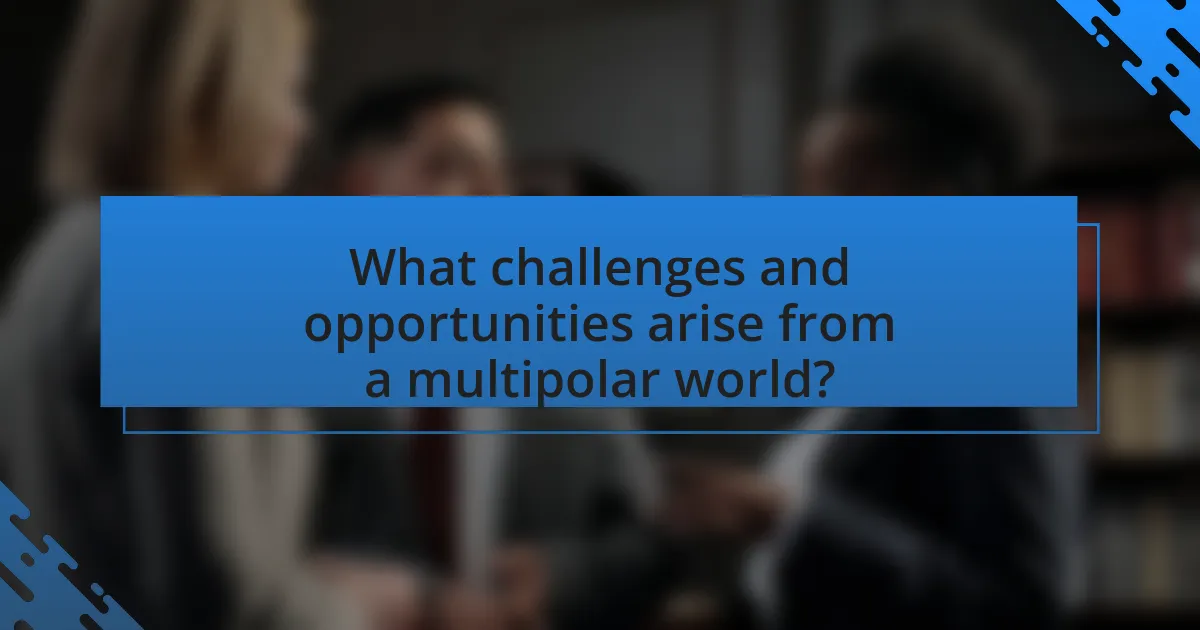
What challenges and opportunities arise from a multipolar world?
A multipolar world presents both challenges and opportunities for international relations. The challenges include increased geopolitical tensions, as multiple powers may compete for influence, leading to conflicts and instability, exemplified by the rising tensions in the South China Sea involving China, the United States, and regional nations. Additionally, the complexity of diplomatic negotiations increases, as diverse interests must be reconciled, making consensus more difficult, as seen in climate change discussions where differing national priorities often hinder progress.
Conversely, opportunities arise from enhanced collaboration and innovation, as nations can form diverse coalitions to address global issues, such as the Paris Agreement, which showcases how multiple countries can unite for climate action despite differing agendas. Furthermore, a multipolar world can lead to a more balanced global power structure, reducing the dominance of any single nation and promoting a more equitable distribution of resources and influence, as evidenced by the rise of regional powers like India and Brazil in international forums.
What are the major challenges facing international relations today?
The major challenges facing international relations today include geopolitical tensions, economic disparities, climate change, and the rise of nationalism. Geopolitical tensions are exemplified by the ongoing conflicts between major powers, such as the United States and China, which have led to trade wars and military posturing in regions like the South China Sea. Economic disparities are highlighted by the widening gap between developed and developing nations, exacerbated by the COVID-19 pandemic, which has hindered global economic recovery and increased inequality. Climate change poses a significant threat, as nations struggle to cooperate on environmental policies while facing natural disasters and resource scarcity. Lastly, the rise of nationalism has led to isolationist policies, undermining multilateral agreements and international cooperation, as seen in the withdrawal of countries from treaties like the Paris Agreement. These challenges collectively complicate diplomatic efforts and threaten global stability.
How do geopolitical tensions manifest in a multipolar world?
Geopolitical tensions in a multipolar world manifest through increased competition among multiple state and non-state actors for influence, resources, and strategic advantages. This competition often leads to regional conflicts, economic sanctions, and military buildups, as seen in the ongoing tensions between the United States, China, and Russia. For instance, the South China Sea disputes illustrate how territorial claims and military presence by China challenge U.S. interests and alliances in the region, heightening tensions. Additionally, the rise of non-state actors, such as terrorist organizations and multinational corporations, further complicates the geopolitical landscape, as they can influence state behavior and exacerbate conflicts.
What role does nationalism play in international relations?
Nationalism plays a significant role in international relations by influencing state behavior, shaping foreign policy, and affecting diplomatic interactions. Nationalist sentiments often drive countries to prioritize their national interests, which can lead to conflicts or cooperation depending on the context. For instance, the rise of nationalism in various countries has been linked to increased protectionism and a focus on sovereignty, as seen in the Brexit movement where the United Kingdom sought to reclaim control over its laws and borders. This shift can disrupt established alliances and multilateral agreements, as nations may become less willing to compromise on issues like trade and immigration. Additionally, nationalism can exacerbate tensions between states, as seen in territorial disputes where national identity is closely tied to land claims, such as in the South China Sea. Thus, nationalism significantly shapes the dynamics of international relations in a multipolar world by influencing how states interact with one another and pursue their interests.
What opportunities can be leveraged in a multipolar international system?
A multipolar international system offers opportunities for enhanced diplomatic engagement, economic collaboration, and diversified security partnerships. Countries can leverage the presence of multiple power centers to negotiate more favorable trade agreements, as seen in the rise of regional trade blocs like the Comprehensive and Progressive Agreement for Trans-Pacific Partnership (CPTPP). Additionally, nations can engage in multilateral forums to address global challenges such as climate change, where diverse perspectives can lead to innovative solutions, exemplified by the Paris Agreement’s broad participation. Furthermore, smaller states can assert greater influence by aligning with various powers, thereby increasing their bargaining power on the global stage. This dynamic fosters a more balanced international order, reducing the dominance of any single nation and encouraging cooperative problem-solving.
How can countries collaborate to address global issues?
Countries can collaborate to address global issues through multilateral agreements, joint initiatives, and shared resources. For instance, international treaties like the Paris Agreement on climate change exemplify how nations can unite to tackle environmental challenges collectively. Additionally, organizations such as the United Nations facilitate dialogue and cooperation among countries, enabling them to coordinate responses to crises like pandemics or humanitarian disasters. Collaborative efforts often involve pooling financial resources, sharing technology, and exchanging knowledge, which enhances the effectiveness of their responses. Historical examples, such as the global response to the COVID-19 pandemic, demonstrate that coordinated actions can lead to more efficient solutions and better outcomes for all involved nations.
What are the benefits of increased diplomatic engagement among diverse powers?
Increased diplomatic engagement among diverse powers fosters enhanced cooperation, conflict resolution, and mutual understanding. This engagement allows nations to address global challenges collaboratively, such as climate change and security threats, which require collective action. For instance, the Paris Agreement exemplifies how diverse nations can unite to tackle climate issues through diplomatic channels. Furthermore, increased dialogue reduces the likelihood of misunderstandings and conflicts, as seen in the establishment of communication hotlines during crises, which help de-escalate tensions. Overall, these benefits contribute to a more stable and interconnected international system, promoting peace and prosperity among nations.
What strategies can nations adopt to navigate a multipolar world?
Nations can adopt several strategies to navigate a multipolar world, including fostering multilateral alliances, engaging in diplomatic dialogue, and enhancing economic interdependence. By forming multilateral alliances, countries can pool resources and strengthen collective security, as seen in organizations like NATO and the European Union, which promote stability through cooperation. Engaging in diplomatic dialogue allows nations to address conflicts and negotiate solutions, exemplified by the ongoing discussions among major powers to manage tensions in regions like the South China Sea. Additionally, enhancing economic interdependence through trade agreements and investment partnerships can create mutual benefits and reduce the likelihood of conflict, as demonstrated by the success of trade blocs such as ASEAN. These strategies enable nations to effectively respond to the complexities of a multipolar international landscape.
How can countries balance their national interests with global cooperation?
Countries can balance their national interests with global cooperation by engaging in multilateral diplomacy that prioritizes mutual benefits while respecting sovereignty. This approach allows nations to address global challenges, such as climate change and security threats, through collaborative frameworks like the Paris Agreement, which demonstrates how countries can commit to collective goals while still pursuing their individual economic and political objectives. By fostering dialogue and establishing international norms, countries can create a balance that aligns their national priorities with the broader needs of the global community, as evidenced by the success of organizations like the United Nations in facilitating cooperation among diverse nations.
What best practices can enhance diplomatic relations in a multipolar context?
Best practices that can enhance diplomatic relations in a multipolar context include fostering open communication, promoting multilateral cooperation, and respecting cultural diversity. Open communication allows nations to address misunderstandings and build trust, as evidenced by the success of diplomatic dialogues such as the ASEAN Regional Forum, which facilitates discussions among multiple countries to resolve regional issues. Promoting multilateral cooperation through organizations like the United Nations encourages collaborative problem-solving and shared responsibilities, which is crucial in a multipolar world where no single nation can address global challenges alone. Additionally, respecting cultural diversity helps to create inclusive diplomatic environments, as seen in the European Union’s approach to integrating diverse member states while maintaining their unique identities. These practices collectively contribute to more stable and constructive international relations.
